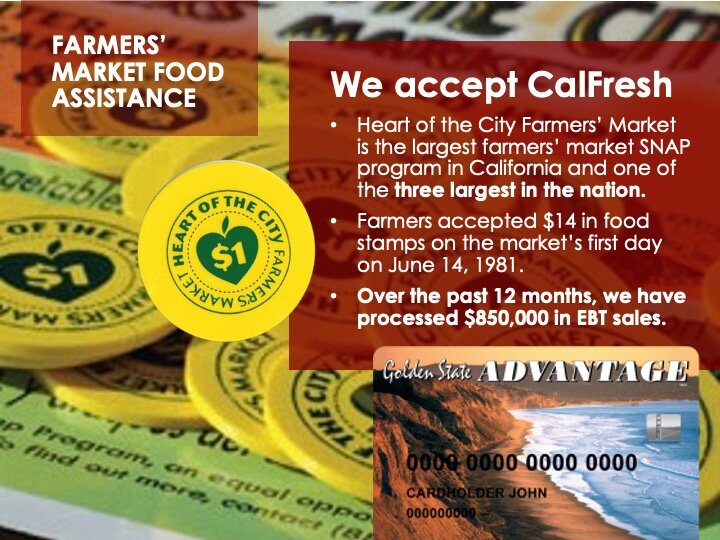The market expansion is the first of several planned activities for the Civic Center Commons this summer, said Joaquin Torres, director of the Mayor's Office of Economic and Workforce Development. Block parties, games and Zumba classes are also in the works.
"We are excited to highlight the best San Francisco has to offer while giving Tenderloin residents, Mid-Market employees, and visitors to the city an opportunity to engage with this vibrant neighborhood," Torres said in a statement.
A vendor selling cherries at the market on Friday, June 7.
According to Creps, the Civic Center farmers market used to be open on Fridays in the 1980s. But crime in the area was too high and business wasn't robust enough to support three markets, so it scaled back to just Sundays and Wednesdays.
The timing of the new Friday market is ideal, Creps explained, because recent legislation has opened up CalFresh, the state's food stamp program, to a new population who can use their EBT dollars to purchase healthy food at the market.
Prior to this year, Californians receiving Social Security (SSI) payments were barred from also receiving food stamps — the only state in the nation where that was the case. But last year, former Gov. Jerry Brown signed a law that makes SSI recipients eligible for CalFresh, which typically provides about $130/month in food assistance to eligible Californians. It went into effect on June 1.
For each $5 in food stamps a customer spends to buy tokens redeemable at its vendors, the market matches them with a free additional $5, Creps explained. The matching funds not only allows low-income people to access healthier food options — it also bolsters revenues for the small local farmers and businesses who sell goods at the market.
The market has an information tent where customers can learn how to apply for and make the most of their CalFresh benefits. Creps said that having an extra day will give the market's staff a chance to better publicize the new law, and ensure more people have access to CalFresh and the market's matching funds.
EBT and other food assistance is welcome at the farmers market, which provides matching funds.
The Civic Center Commons initiative and SF Etsy have greatly smoothed the process of re-launching the Friday market, Creps said. For example, the city already provides stewards (through nonprofit Urban Alchemy) to monitor UN Plaza on Fridays, which cuts down on Heart of the City's security costs.
Civic Center Commons is also providing tents and tables to host vendors from SF Etsy each week, and covering the permitting costs associated with the market.
Getting Heart of the City's farmers on board was tougher. Creps said that some were reluctant to increase their appearances to three times a week, because it can cost more than $500 for them just to get to and from San Francisco and cover the costs of any unsold leftover products.
But several farmers agreed to participate for a trial run, and others may join if the market proves profitable, Creps said.
Shoppers visiting SF Etsy vendors at the first Friday market on June 7. | PHOTO: COURTESY OF THE CITY OF SF
SF Etsy, which partnered with Civic Center Commons last year to host first Sunday shopping events, was excited to get a chance to come back for the new Friday market, said Rebecca Saylor, who helped curate the SF Etsy vendors.
Saylor, who makes custom pillows as OodleBaDoodle, put out a call to potential vendors and received interest from more than 70 local artists. The city's assistance with tables, tents, and marketing significantly reduces the barrier to participation, she said.
Some vendors will likely be staples, such as letterpress card and stationary maker Leah Jachimowicz, while others will rotate. Shoppers can expect to find a wide variety of crafts, including glass art, eco-friendly jewelry, and screenprints. A regularly updated Pinterest board will feature the line-up of each week’s participating vendors.
The new vendors will sell their wares alongside the UN Plaza Gift Gallery, which already operates a craft market every Thursday and Friday. The Friends of the Public Library will also be selling used books on the first Friday of each month.
The Friends of the Public Library will sell books the first Friday of the month. | PHOTO: COURTESY OF THE CITY OF SF
Starting around noon each week, the market will also offer a free do-it-yourself project for attendees. For its first few weeks, local graffiti artists from 1AM will be on-site with tote bags, spray paints, and stencils, Flynn said.
Market customers can work with one of the artists, or try their own hand at tagging a new tote for their market purchases.
1AM artists helping market visitors paint their own tote bags. | PHOTO: COURTESY OF THE CITY OF SF
Square, which helped curate the market's vendors, is currently the only private sector partner for the event, said Civic Center Commons' Julie Flynn, with SF Etsy, Heart of the City, and the Civic Center Community Benefit District offering in-kind support.
The market is still open to other potential sponsorships, and to further tweaks to its hours and vendor mix.
“We’re very much in the feedback stage,” Flynn said, adding that anyone with comments or questions about the Friday market can contact her through the organization's website.
The Friday market is open from 7 a.m. to 4 p.m. each week, though some vendors will stay open until as late as 6 p.m., Flynn said.
The one exception is Pride Week: the market will close on Friday, June 28 to accommodate the celebration in Civic Center Plaza.
Read more at Hoodline.com.






















